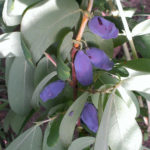Rose Gloria Dei
The name of this rose is well known to every rose grower, not only in Russia, but also abroad. For more than a decade, Gloria Day has been considered the benchmark among hybrid tea varieties. In 1970, the variety was included in the State Register of Breeding Achievements of Russia with admission to cultivation in all regions of the country and a recommendation for production reproduction. The originator was the Mayskiy Plemzavod SHPK. Gloria Dei is not only incredibly beautiful, but has an amazing history.
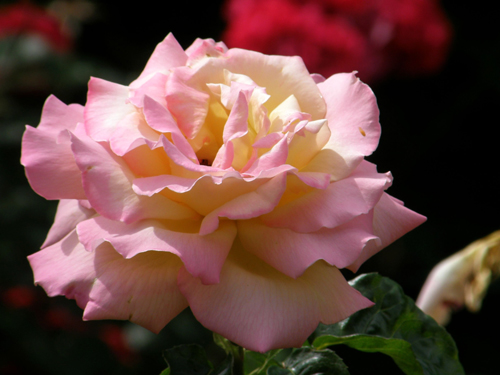
History of creation
Few people know, but this delicate beauty could have remained just an unsuccessful experiment in an attempt to propagate the hybrid you like. But, everything is in order. In 1935, in the French family nursery Meilland, the usual work was going on - hybrids grown from their own seeds were evaluated. Most of them were discarded. Attention was drawn to only a single copy, which was assigned the working number 3-35-40. This hybrid had a large double flower with an unusually beautiful color. The problem was that only 3 buds were suitable for vaccination, which made further breeding difficult. As a result, only one bud took root, but it was she who became the very variety that in a few years will make a real sensation in the world of rose growing and set a new standard for the quality of roses. But the rising star on the way to world recognition had to endure another misadventure. In 1942, German troops entered France, and in order to save an unusual specimen, it was decided to secretly transport it to America. Gloria Day returned to her homeland only after the end of the war. And it was in 1945 that the whole world learned about our heroine.
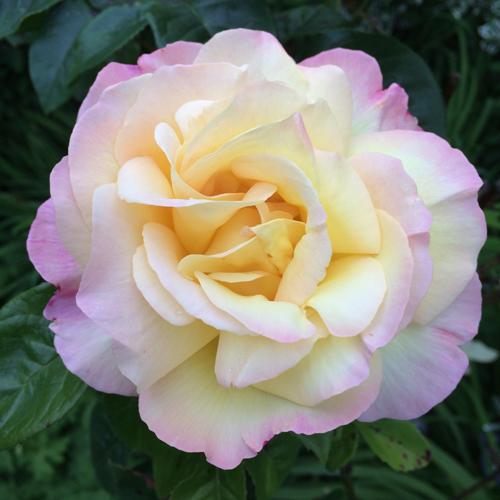
Rose name
François Meilland, son of the head of the family business, dedicated this magnificent flower to his early departed mother, so the original name of the variety sounds like Mme Antoine Meilland. Exhibition name - Peace. Under the same name, our heroine was presented in English-speaking countries. In Germany she is known as Gloria Dei (Glory to God), and in Italy her name is Gioia (Joy). In the USSR, it gained the greatest popularity under the name Glory to the World.
Origin
The birth of Gloria Day cannot be called accidental; years of painstaking work and thoughtful selection led to it. Several species served as the parental forms of our heroine: seeds obtained from crossing (Georqe Dickson x Souv. De Claudius Pernet) x (Johanna Hill x Charles Kilham) and pollen from Marqaret McGredy.
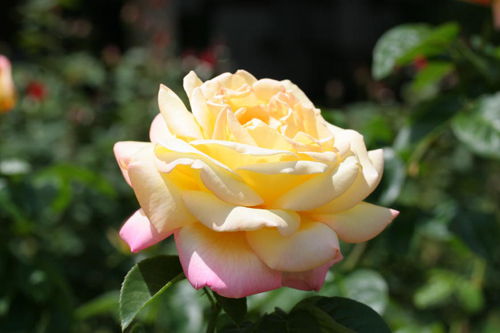
Awards
In August 1945, the All-American Bureau of Pink Breeding awarded the Peace Prize, and it was on this day that the war with Japan ended. And on the day of the signing of the peace treaty with Japan, our heroine was awarded the Gold Medal - the highest award of the American Rose Society. Isn't it an amazing coincidence, considering that all the events were planned long before the historical events. The peak of popularity of the variety fell on the 50s - 60s of the last century. It was then that rewards fell on the beautiful flower as if from a cornucopia. In 1965, Gloria Dey was awarded the title of "Golden Rose" in The Hague. In 1976, he was inducted into the Hall of Fame by the decision of the World Federation of Pink Societies. In 1993 he was awarded the Garden Merit Award from the Royal Horticultural Society.
Description
Vigorous bush, classical straight shape, branched, powerful, 100 - 150 cm high (according to some sources, up to 2 meters). The width of the bush is up to 90 - 125 cm. The shoots are long, with an average number of large thorns. The leaves are large, dark green, shiny, dense, with well-visible veins. Even a non-flowering bush looks decorative. The number of buds on the stem is 1, but sometimes inflorescences from several, but not more than 6, appear.
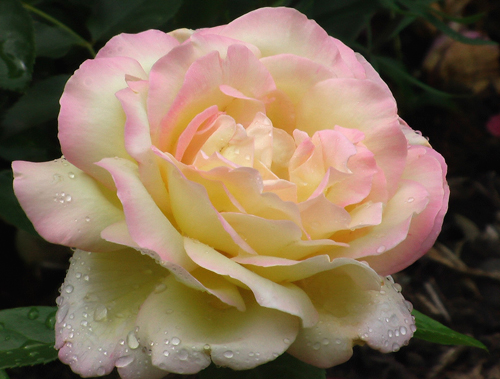
The bud of the hybrid tea beauty Gloria Dei is incredibly large. The flowers retain their attractive appearance at all stages of dissolution, from the tall, elegant goblet-shaped bud to the stage of full disclosure, in which the peony shape is acquired.The diameter of the rose is 13 - 16 cm. The buds are densely double, numbering from 26 to 43 (sometimes more) petals. The petals feel like silk. They are painted in a pale yellow color, which, closer to the edges, acquires a pink-red or crimson edging. Burning out in the sun, the petals of Gloria Day become creamy pink. The American rose grower Robert Pyle, who took care of the cultivar during the Second World War, described the flower's appearance as follows: "My eyes are blinded, I admire a huge yellow canary, framed by a crimson halo." But in culture, the color of the flower can change depending on the season and place of cultivation. The aroma is light and pleasant, it can be described as moderately pronounced. There are exceptions, though. Some complain about the complete absence of smell, for others, on the contrary, the smell is too strong.
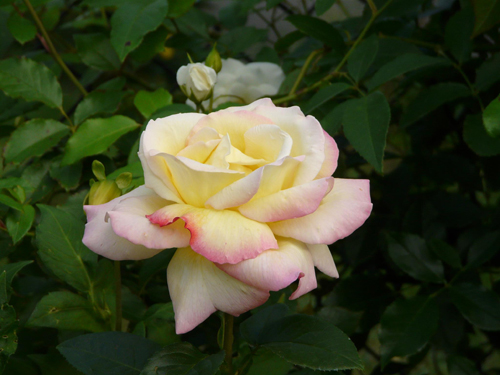
Bloom
Gloria Day is a multi-flowering species. In fact, it turns out that the bush is able to bloom almost continuously throughout the summer, and in warm regions before the onset of cold weather. But for this you need to timely remove faded brushes. The first flowering begins in the third decade of June and lasts a whole month. During this period, an adult bush forms more than 40 buds. But the flower does not last long, after 3 - 4 days it fades. The second wave of rose bloom, with proper care, also pleases with its large-bloom, but the number of flowers is already moderate.
Characteristics
- The decorative qualities of Gloria Day can be judged 2 - 3 years after planting, when the bush is gaining vegetative mass;
- winter hardiness is good, corresponds to 6 USDA zone (US Department of Agriculture). This means that the bush will calmly survive the winter temperature drop to -23.3 ° C. This zone includes the Krasnodar Territory, Crimea, the Caucasus, western and southern regions of Ukraine. But, according to reviews, the plant tolerates winters well in the Moscow region and the Leningrad region, of course, under cover;
- the immunity of the rose is good, despite the fact that the variety is old. It can be affected by powdery mildew and black spot in especially unfavorable years, but generally speaking, most reviews speak of high disease resistance. Gloria Day is good at resisting pests;
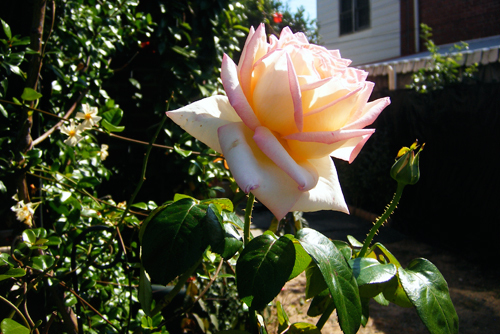
- resistance to wet weather is above average. In warm regions, rainy weather does not in any way affect the aesthetic appearance of the flower. But in cool regions, with a general cold snap and damp weather, some roses may be damaged, and gray rot may appear on the buds;
- the flower feels good in the sun, but in extreme heat the flowers fade earlier than usual, while the yellow color fades, but the pink becomes brighter.
Varieties
Gloria Day was widely used in breeding and became the progenitor of many famous species. For example, in the Soviet Union, with her participation, breeders bred such varieties as Scarlet Sails, Alma-Atinskaya Aromatic, Vasilisa the Beautiful, Kazakhstani Jubilee, Festival Beauty, Komsomolsky Ogonyok, Major Gagarin. Abroad, with her participation, the varieties Chicago Peace, Mitsouko, Princess de Monaco, Kronenbourg, Pullman Orient Express, Dame de Couer appeared. In the 50s, in different countries, independently of each other, the climbing form of Peace called Peace CI was selectively fixed.
Planting and agricultural technology
Before choosing a planting time, analyze the climatic conditions of the region, because the success of the event will depend on the correct timing. Although many growers prefer to carry out this procedure in the fall - a month before the onset of persistent cold weather. Choose a sunny place, because the rose is photophilous and loves to swim in the sun. But again, there are nuances. If you are a resident of the sultry south, then choose a place so that in the midday hours the queen of the flower bed is protected by a light partial shade. Gloria Day develops best at temperatures between 15 and 28 ° C.The soil should be nutritious and light, with moderate acidity.
Watering is required plentiful, but in between wetting the soil should have time to dry out. For a bright flowering, nutrients are needed, so regular fertilizing with universal fertilizers will benefit the rose. It is especially important to feed the plant before the second flowering. Gloria Dei does not tolerate heavy pruning. During the growing season, it is necessary to remove faded flowers in time, allowing the buds to open on time. If in winter there is no snow cover, and at the same time the temperature drops below the critical one, then the bush must be covered with dry earth and covered with any breathable material. For this, spruce branches or lutrasil are suitable. Canina rose (dog rose) or rugoza (wrinkled rosehip) are used as an inoculation.
Gloria Day is rightfully considered a strong and hardy variety that forgives inept gardeners for their small flaws. Magnificent flowering evokes wonderful feelings and positive emotions in those around you. The culture, unpretentious in care, is very popular in landscape design, it is magnificent in a single planting, it will not get lost in a composition with other plants and varieties of roses. A large bud and a long stem are the components of a beautiful bouquet, so the variety is often grown for cutting. In order to create an unusual corner for relaxing in the garden, the plant is formed as a standard shape. There are a lot of delightful reviews about this variety, even after more than a dozen years Gloria Day continues to win hearts. This variety is rightfully recognized as the rose of the 20th century, as Robert Pyle sagaciously spoke about, with whose words I would like to end the story of an amazing flower with a difficult fate: "This is so magnificent, full of promise, and I am already sure that it will be the greatest rose of the century."

